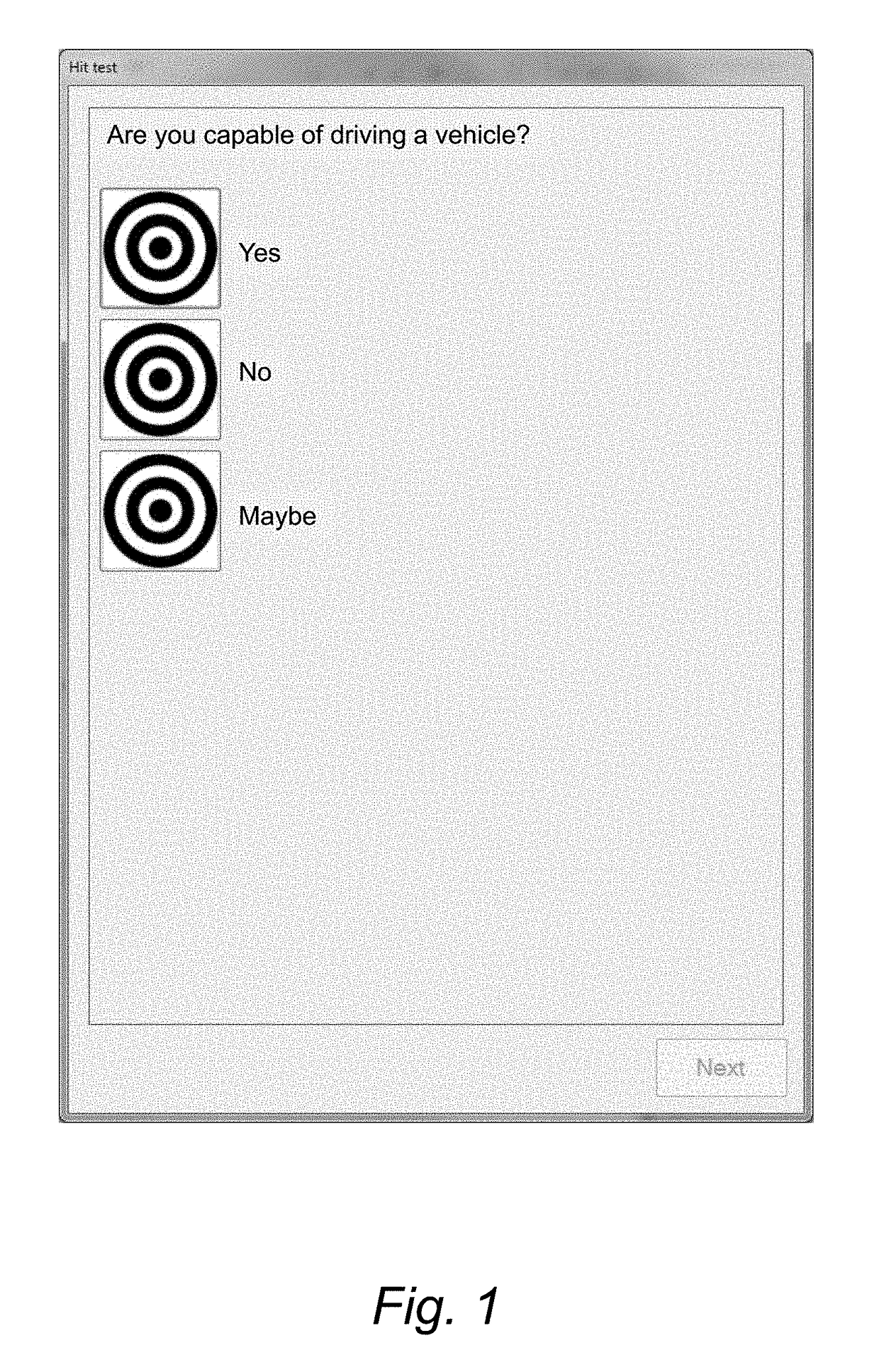Method and device for estimating a risk of relapse of addictive behaviour
a risk and addictive behavior technology, applied in the field of addictive disorders, can solve the problems of destroying the private economy, high health care costs, and serious threat to modern society of addictive disorders, and achieve the effect of estimating the risk of addictive behavior
- Summary
- Abstract
- Description
- Claims
- Application Information
AI Technical Summary
Benefits of technology
Problems solved by technology
Method used
Image
Examples
example 1
[0116]In the present example, the ability for a measurement device to capture alcohol consumption through use of a small and simple questionnaire was tested. A questionnaire was designed to have three questions.
[0117]Question one was “Are you capable of walking 5 m on a straight line painted on the floor?” Three possible answers were made available: Yes, No, Maybe.
[0118]Question two was “Please estimate your current blood alcohol level”. The answer was provided through setting a marker on a continuous scale.
[0119]Question three was “Are you capable of driving a vehicle?” Three possible answers were made available: Yes, No, Maybe.
[0120]The multiple choice questions (1 and 3) had large buttons (approximately 2*2 cm) with concentric circles, as shown in FIG. 1. The questionnaire was programmed as a standalone application and was run on a tablet computer equipped with a touchscreen, so that the individual being tested used his or her finger or a pen suitable for touchscreens to indicate...
example 2
[0125]This example shows that it is possible to estimate if an individual is at risk being intoxicated. Twelve individuals known to have an adverse drinking behavior were provided with a portable blood alcohol measurement device (Kontigo tripleA) which is communicating with a central server unit for receiving information about when next measurement is scheduled and for storage of measurement results. At the time a of blood alcohol measurement, a brief questionnaire with questions related to mood and well-being was shown to the individual and questionnaire results are stored in the central server unit. For each individual, a sobriety index (SI) for monitoring misuse of alcohol of an individual was composed of the actual measured blood alcohol values (requested three times per day) combined with recent missed measurements. Unwanted results (elevated blood alcohol level or missed measurement) were given additional penalty if occurring evening or morning, and if occurring consecutively....
example 3
[0130]This example shows that it is possible to use SI for estimating if an individual is at risk being intoxicated. Data from three individuals being part of the same clinical study as described in Example 2 above are shown in FIG. 6. The three individuals were, in addition to being part of the monitoring program, also monitored using biomarkers indicative of alcohol consumption, including blood biomarkers Phosphatidylethanol (PEth) and Carbohydrate-Deficient Transferrin (CDT). Urine biomarkers ethyl glucuronide (EtG) and ethyl sulfate (EtS) can also be used for monitoring short term consumption. Since PEth is eliminated from the body with approximately 4-5 days half-life, it is a suitable biomarker for confirming alcohol consumption recent week. Use of PEth, CDT, EtG and EtS has been discussed in “Monitoring of the alcohol biomarkers PEth, CDT and EtG / EtS in an outpatient treatment setting.” as published by Helander and co-authors in Alcohol Alcohol. 2012 September-October; 47(5):...
PUM
 Login to View More
Login to View More Abstract
Description
Claims
Application Information
 Login to View More
Login to View More - R&D
- Intellectual Property
- Life Sciences
- Materials
- Tech Scout
- Unparalleled Data Quality
- Higher Quality Content
- 60% Fewer Hallucinations
Browse by: Latest US Patents, China's latest patents, Technical Efficacy Thesaurus, Application Domain, Technology Topic, Popular Technical Reports.
© 2025 PatSnap. All rights reserved.Legal|Privacy policy|Modern Slavery Act Transparency Statement|Sitemap|About US| Contact US: help@patsnap.com



